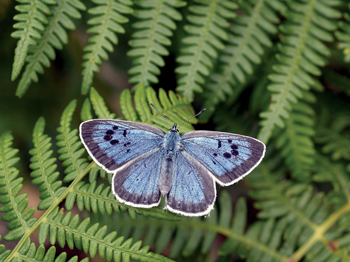“I’ve watched you now a full half-hour,” William Wordsworth observed to a butterfly he found in his orchard one morning. While most of us could not conjure a poem out of it, there is something about a butterfly that never fails to lift the heart. (However, Wordsworth’s delight in butterflies came late in life. He told his sister Dorothy that he and his friends used to “kill all the white butterflies at school because they were Frenchmen”.)
Butterflies are one of the glories of the countryside. Even their names are delightful, from the lyrical Silver-Spotted Skipper, Pearl-Bordered Fritillary and Silver-Studded Blue to the noble Duke of Burgundy and the less exotic-sounding Dingy and Grizzled Skippers. But every butterfly, even the prosaically named Browns, is special to Butterfly Conservation, which celebrates its 40th anniversary this year. Martin Warren, its chief executive, gives the history: “The organisation was started in 1968 by two London City gents who noticed that many butterflies seemed to be declining. They quickly got Sir Peter Scott involved – people don’t realise he had a strong interest in butterflies. The first set of minutes record a member saying they will have to explain the word ‘conservation’ to people.
“Many people cared passionately about butterflies, but while they knew they weren’t seeing so many about, they didn’t know why. There were no hard facts available,” Warren continues. Butterfly Conservation’s greatest achievement has been to harness people’s natural affection for butterflies and collate accurate information on our 60 or so species.
Butterfly Conservation runs one of the world’s largest butterfly recording schemes. Some 10,000 volunteer recorders send in five million butterfly records each year, which is a staggering number for an organisation that for many years had a very small membership.
“We get a phenomenal amount of information,” says Warren. “That allows us to produce The State of Britain’s Butterflies report, which charts the overall pattern of decline. Generally, seven out of 10 species are in decline. In the past 150 years we’ve lost five species, and at present around 20 species are threatened. But it’s not all doom and gloom. If you include common migrants, such as the Red Admiral, Painted Lady and Clouded Yellow, they’re becoming much more common. Some 15 species are extending their northern ranges, the most spectacular example being the Comma, a ragged-winged butterfly, which has been travelling north at the rate of 10km a year.”
Another success story is the reintroduction of the Large Blue. Having disappeared entirely, the discovery that its caterpillars lived in ants’ nests led to caterpillars from butterflies reared in Sweden being released – first in Devon, then on other sites. Now there are tens of thousands flying around, and we enjoy one of the biggest populations in Western Europe.
Unsurprisingly, loss of habitat is the biggest factor in butterfly decline. Butterfly Conservation states that 90 per cent of flowering grassland has gone in the past 50 years, while the woodland species have suffered the biggest decline as woodland falls out of active management and the open, sunny rides they require are lost.
Butterflies are excellent habitat indicators; generally, if somewhere is right for them, it is right for most other species. But butterflies are particular little creatures, and the reason for decline of a certain species in one place may not be the same as for another spot. This is where hard information is so crucial for managing sites effectively. “It’s all about the detail,” says Warren. “For instance, different species require varying grazing levels. If a rare species likes tall grass, it’s easy to get that wrong. One problem is that as habitat reduces to smaller areas, there’s less margin for error.
“We work closely with landowners and farmers, and we get a pretty good response, which is heartening. We rely on landowners – just an odd rough corner will help butterflies, and we always welcome people getting involved, particularly in rural areas where local volunteers may be thinner on the ground.”
To this end, Butterfly Conservation’s website offers advice and fact sheets and can help facilitate access to grants. The website details everything from talks and site visits to advice on the best garden plants for butterflies, and it has a good identification facility for anyone who feels he could just about identify a Red Admiral but not much more.
Another achievement Butterfly Conservation is proud of is the rehabilitation of moths, and its The State of Britain’s Moths documents our 2,500 different species. “People’s eyes glaze over if you mention moths,” says Warren, “but they’re fascinating, and often spectacular-looking. They’re crucial in the food chain.” Moth-trapping has proved popular at organised events or in home gardens. It’s a big hit with children who, like Wordsworth, find all these insects fascinating.
For more information on Butterfly Conservation call 01929 400209 or visit the website.





